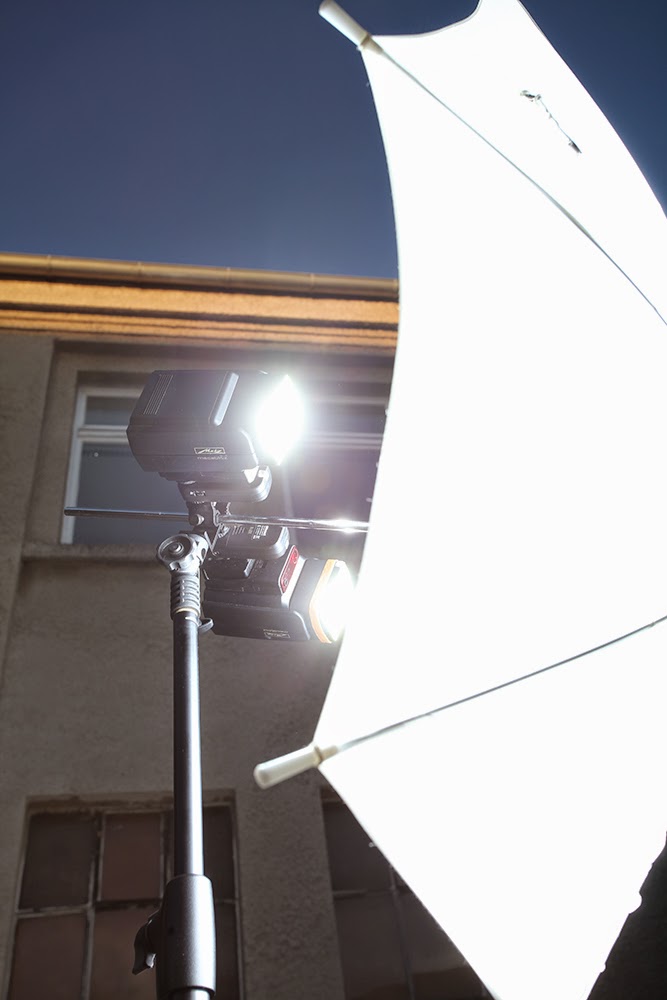I placed my speedlight about 50cm away from a white paper. First, I tested for a black shot, eliminating existing light. Then, just for curiositsy, did a bare bulb shot at 24mm zoom and one at 85mm, chosen deliberately.
Okay, there´s no more ambient light at f/11, 1/250. I can see the vignette of the 24mm blast at this distance. I´m good to go.
Please note the shape of the speedlight´s projection. Designed to throw light forward and serve the frame of the camera it was made to be put on, a speedlight does not produce a gentle round spot, but a rectangular-ish pattern.
First, I put on the snoot from the Calumet Speedlight Modifier Set, which is sold under many different brand names in many countries. I didn´t expect too much...
This thing is difficult to mount and has two slip-on grids which will always fall off.
Look at the pattern. Yes, it cuts down the light, but retains the distorted shape of the speedlight´s original output.
Please note that this will most likely happen with any even more expensive snoot solution! Say, you´re spending a few hundred bucks on a Bowens snoot and speedlight adapter - it will probably look the same. This is mostly because the snoot is black on the inside. A white interior would diffuse the light in the inside before snooting it. The flash is at 85mm here.
While at it, let´s go for the mini dish which is included in this set and see if it´s any good:
Uh... The bare dish has heavy spill (I´m still at 85mm to MINIMISE spill!). So I put on the white plastic "fresnel" style disc (shot 2). I actually used this as a gradient background light in my portraiture a few times. But when you put on the grid, VERY ugly things start to happen (shot 3).
Experience tells me that this dish tends to lose the deflector very quickly when moved around.
At this time I must conclude that the only REALLY useful things in that Calumet set are the diffusion dome and, well, the mini dish if you put the white disc on.
I never tested the coloured discs or the golden deflector. They look too pathetic to me. Also, please excuse I only tested one of the three grids, but I guess the other two won´t do any better.
I love the Expoimaging Rogue modifier range. Let´s check out the Flashbender if it can snoot better:
Well.... no. I mean, yes! It does a better job than the plastic crap in the last run, but its shape is so hard to control that you cannot produce a round reflection. It´s great as a general snoot for hair or kicker lights or accents from either side of the set. But straight-on snooted flash is not very good. Its secret, however, is the white inside! This helps a speedlight produce a spot with much better falloff. But as you can see, the flashbender does much better when used as a reflector or flag. Actually, it´s my go-to thing to have on a tethered TTL flash in my left hand when shooting events.
Next up: The Rogue 3-in-1 grid:
Easy to see, this is the winner. Its spot is a perfectly round circle, even with the flash at its widest setting. Again, the secret is the white inner coating.
It´s a cinch to put on, it´s sturdy and well-crafted, it´s pretty much failsafe and very innovative. Well worth the money! It packs in a very small bag and will always fit in your bag. You can also order colored gels with it (they are specially cut-out to fit; the yellow one came with it). Bonus feature: the sleeve without the grid holder makes a nice spill kill if you use an umbrella.
As you can see, there is minimal projection of the honeycombs at the rim which will go away at real-life working distances.
I highly recommend you get two of these if you want to have control over light spill or actually use them as a spotlight in every aspect of photography. I love to have them on my kicker lights as they keep my lens clean from flare. Maybe I will use them as a round spot in a future still ilfe shot, now that I know for sure they can do it.






.jpg)
.jpg)
.jpg)
.jpg)



























